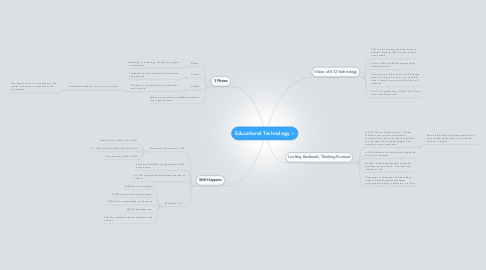
1. Vision of K12 Technology
1.1. 76% of teachers never use wikis, blogs, or podcast; however, 14% use them at least once a week
1.2. China by 2016 will be the largest english speaking country
1.3. There are more honor students in China than there are in North America, and out of the ones in North America only half of them will graduate.
1.4. The 21 first generation will have 10 to 14 jobs by the time they are 38
2. Looking Backward, Thinking Forward
2.1. In 1922, Thomas Edison quoted "I believe that the motion picture is destined to revolutienize our educational system and that in a few years it will supplant largely, if not entirely, the use of textbooks"
2.1.1. We are almost there in todays generation, w can now find books online and purchase books on a kindal
2.2. In 1923 slides/motion pictures were supposed to improve instruction
2.3. By 2000, technology advanced rapidly. We now have laptops, ipods, social networks, cellphones, etc
2.4. Technology in education has always been around; moreover, technology keeps improving and making it easier for us to learn
3. Shift Happens
3.1. The internet was created in 1995
3.1.1. Ebays revenu in 2006 was 6 billion
3.1.2. 2.7 billion people used google this month
3.1.3. 1 8 people met online in 2005
3.2. Technical information is supposed to double every 2 years
3.3. A 1,000 computer will exceed the knowlede of a human
3.4. By the age of 21...
3.4.1. 20,000 hours TV watched
3.4.2. 10,000 hours of video games played
3.4.3. 10,000 hours spent talking on the phone
3.4.4. 250,000 messages sent
3.4.5. 50% have created at least something on the internet
4. 3 Phases
4.1. Phase 1
4.1.1. Beginning of technology: Teachers use maybe a smart board
4.2. Phase 2
4.2.1. Textbooks are kind of replaced, teachers start using the web
4.3. Phase 3
4.3.1. The three c's: Communication, Calliboration, and Creativity
4.3.1.1. Students are looked at as more of a producer
4.3.1.1.1. They begain to use more applications like movies, podcasts, or presentations like powerpoints
